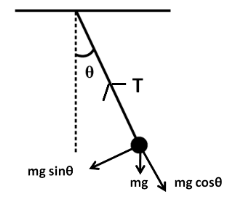
The tension in the string of a simple pendulum is
(A) Constant
(B) Maximum in the extreme position
(C) Zero in the mean position
(D) None of these
Answer
487.2k+ views
1 likes
Hint:
The bob of the pendulum undergoes vertical circular motion. So, obtain the expression for the tension in the string for vertical circular motion and check for the required conditions.
Complete step by step answer:

Consider a pendulum with a bob of mass
Centripetal force,
where R is the length of the string.
Net force towards the centre,
Equating (1) and (2), we have
Or,
This is the expression for the tension at any instant.
As the bob performs the circular motion, the value of
In the extreme position, the value of
Or,
We know from Trigonometry that the maximum value of
In the mean position, the value of
Or,
So, after checking each and every option, we conclude that none of the options A, B or C are correct.
Hence, the correct answer is option (D); none of these.
Note:
For attempting these kinds of questions, always prefer to obtain the mathematical expression of the quantity concerned, as we obtained (3) in this question. Then the application of Calculus and Trigonometry will lead you to the correct answer. Don’t try to solve the question physically, as in the questions of more difficult level, you might make errors.
The bob of the pendulum undergoes vertical circular motion. So, obtain the expression for the tension in the string for vertical circular motion and check for the required conditions.
Complete step by step answer:

Consider a pendulum with a bob of mass
Centripetal force,
where R is the length of the string.
Net force towards the centre,
Equating (1) and (2), we have
Or,
This is the expression for the tension at any instant.
As the bob performs the circular motion, the value of
In the extreme position, the value of
Or,
We know from Trigonometry that the maximum value of
In the mean position, the value of
Or,
So, after checking each and every option, we conclude that none of the options A, B or C are correct.
Hence, the correct answer is option (D); none of these.
Note:
For attempting these kinds of questions, always prefer to obtain the mathematical expression of the quantity concerned, as we obtained (3) in this question. Then the application of Calculus and Trigonometry will lead you to the correct answer. Don’t try to solve the question physically, as in the questions of more difficult level, you might make errors.
Latest Vedantu courses for you
Grade 10 | MAHARASHTRABOARD | SCHOOL | English
Vedantu 10 Maharashtra Pro Lite (2025-26)
School Full course for MAHARASHTRABOARD students
₹33,300 per year
Recently Updated Pages
Master Class 11 Economics: Engaging Questions & Answers for Success

Master Class 11 Business Studies: Engaging Questions & Answers for Success

Master Class 11 Accountancy: Engaging Questions & Answers for Success

Master Class 11 English: Engaging Questions & Answers for Success

Master Class 11 Computer Science: Engaging Questions & Answers for Success

Master Class 11 Maths: Engaging Questions & Answers for Success

Trending doubts
State and prove Bernoullis theorem class 11 physics CBSE

1 ton equals to A 100 kg B 1000 kg C 10 kg D 10000 class 11 physics CBSE

State the laws of reflection of light

One Metric ton is equal to kg A 10000 B 1000 C 100 class 11 physics CBSE

Difference Between Prokaryotic Cells and Eukaryotic Cells

1 Quintal is equal to a 110 kg b 10 kg c 100kg d 1000 class 11 physics CBSE




